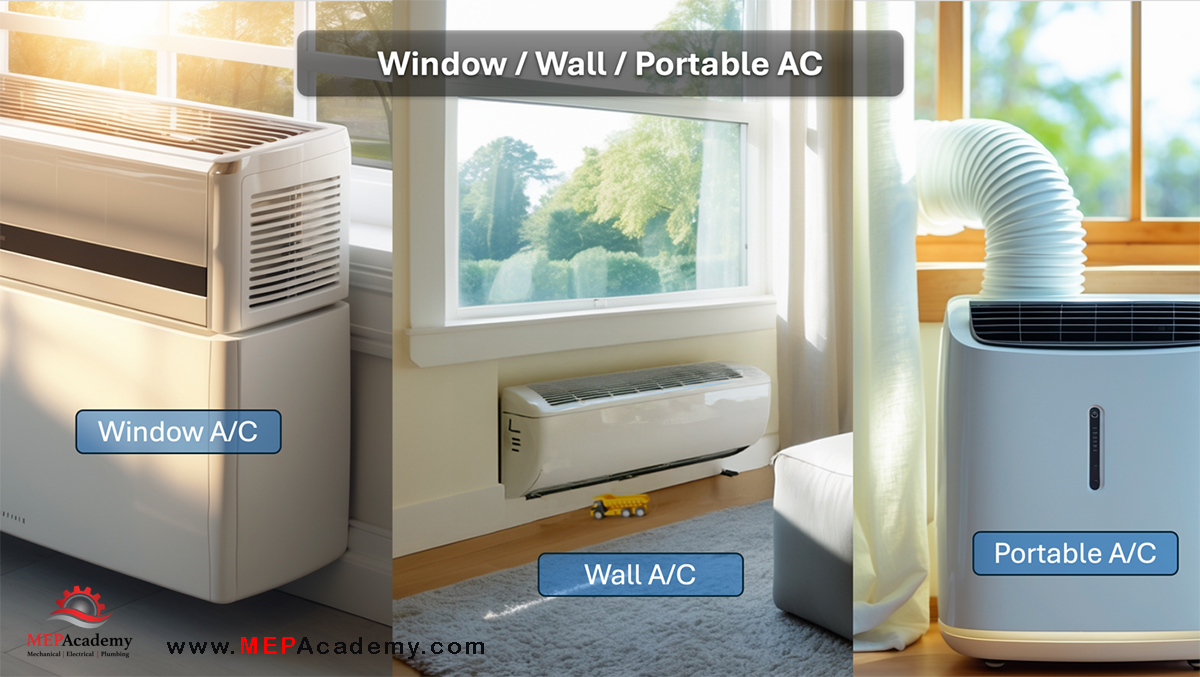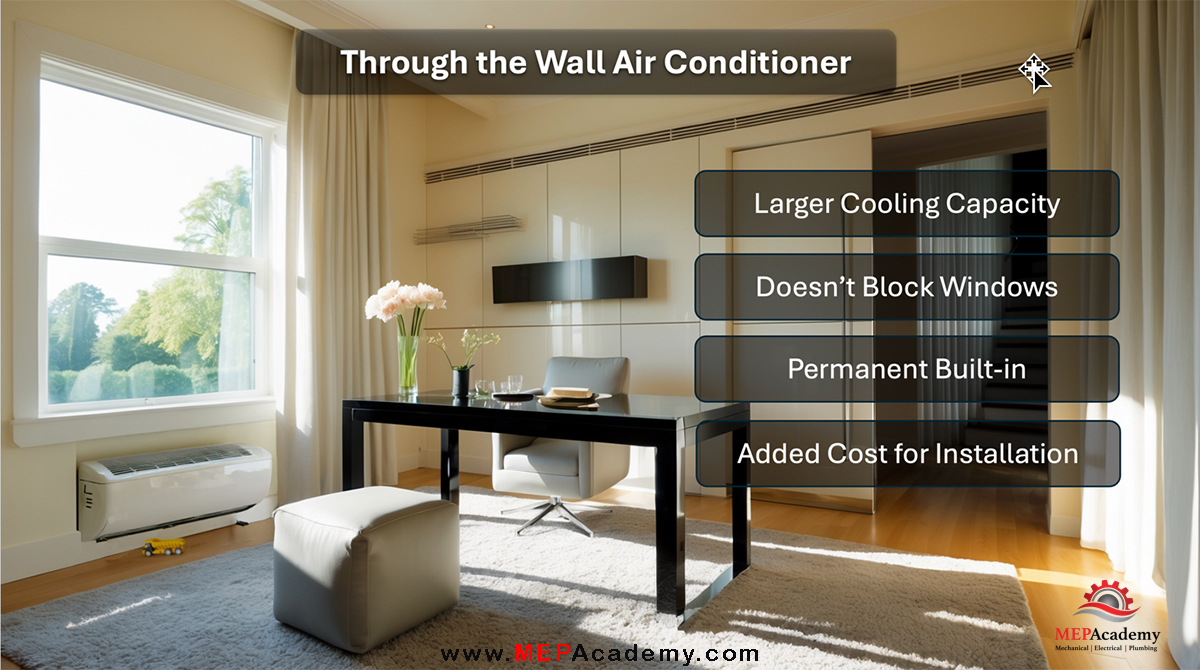When it comes to cooling individual rooms or small spaces, homeowners and renters often debate between a Portable vs Window Air Conditioner, or thru-the-wall units. Each type has its strengths and limitations, and the best choice depends on your specific needs, room layout, and personal preferences.
This guide provides a comprehensive comparison—covering efficiency, noise, cost, capacity, features, aesthetics, and overall pros and cons—to help you make an informed decision.
Quick Overview

Portable Air Conditioners
- Freestanding units that sit on the floor and vent hot air through a window or opening using a hose.
- Typically plug-and-play with minimal setup.
- Ideal for renters or rooms where window installation isn’t possible.
Window Air Conditioners
- Installed in a window opening.
- Most common type of room AC in the U.S.
- Good balance of cost, performance, and availability.
Thru-the-Wall Air Conditioners

- Installed through a hole cut in an exterior wall.
- Similar to window units but designed for permanent, built-in installation.
- Great for homeowners looking for a cleaner, built-in aesthetic.
1. Efficiency
| Type | Efficiency Rating (EER/CEER) | Notes |
| Portable ACs | 6–9 CEER (lower efficiency) | Often struggle to cool larger areas due to heat leakage from the hose and indoor compressor placement. |
| Window Units | 9–12+ CEER (moderate-high) | Typically more efficient than PACs. Some ENERGY STAR-rated models available. |
| Wall Units | 9–12+ CEER (moderate-high) | Comparable to window units, especially if properly insulated during installation. |
💡 Note: Dual-hose portable ACs are more efficient than single-hose models due to reduced air pressure issues.
2. Noise Levels
- Portable ACs: Generally louder (50–70 dB) because the compressor and fan are inside the room.
- Window Units: Quieter (40–60 dB); compressor is outside the window.
- Wall Units: Similar noise profile to window units, though high-end models can be surprisingly quiet.
🔇 For bedrooms or quiet environments, window or wall units usually offer a more peaceful experience.
3. Cost Differences
| Type | Unit Cost Range | Installation Cost | Maintenance Cost |
| Portable ACs | $300–$700 | Minimal (DIY) | Low |
| Window Units | $150–$800 | Minimal (DIY) | Low |
| Wall Units | $400–$900 | Moderate ($150–$500) | Low |
- Portable ACs are pricier relative to their performance.
- Window Units are the most cost-effective per BTU.
- Wall Units have higher upfront costs but offer a cleaner look and may last longer.
4. Cooling Capacity
- Portable ACs: Usually range from 8,000 to 14,000 BTU (best for rooms up to ~500 sq. ft.).
- Window Units: Available from 5,000 to 24,000 BTU, covering rooms up to ~1,400 sq. ft.
- Wall Units: Also range 8,000 to 24,000+ BTU, suitable for larger areas.
📏 BTU Tip: Measure your space and match the unit size for optimal comfort and efficiency.
5. Features
| Feature | Portable AC | Window AC | Wall AC |
| Remote Control | ✅ | ✅ | ✅ |
| Smart/Wi-Fi Control | ✅ | ✅ | ✅ |
| Dehumidifier Mode | ✅ | ✅ | ✅ |
| Timer & Sleep Modes | ✅ | ✅ | ✅ |
| Heat Pump Option | ✅ (some) | ✅ (some) | ✅ (many) |
All three types offer similar features. However, smart features (like app control, scheduling, and energy monitoring) are increasingly common across all categories.
6. Aesthetics
- Portable ACs: Bulky and conspicuous; take up floor space. Large exhaust hose can be unsightly.
- Window ACs: Block the view and light from windows; can look bulky from the outside.
- Wall ACs: Most aesthetically pleasing when installed flush with the wall and properly trimmed. They free up windows and floor space.
7. Advantages & Disadvantages
✅ Portable Air Conditioners
Pros:
- No permanent installation.
- Easy to move between rooms.
- Good for renters or temporary setups.
Cons:
- Lower efficiency.
- Noisier.
- Takes up floor space.
- Single-hose models can create negative pressure.
✅ Window Air Conditioners
Pros:
- Higher efficiency and cooling power.
- Inexpensive.
- Easy DIY install.
Cons:
- Blocks window use.
- Not suitable for all window types (e.g., casement windows).
- Visible from inside and outside.
✅ Thru-the-Wall Air Conditioners
Pros:
- Permanent, built-in solution.
- Doesn’t block windows.
- Quieter than portable units.
Cons:
- Requires wall modification (not ideal for renters).
- Professional installation recommended.
- May reduce resale value if not done cleanly.
8. Types of Window and Wall Units
Window Units:
- Standard (horizontal slide): Most common for double-hung windows.
- Casement/Slider: Tall and narrow models for vertical windows.
- Smart Window ACs: Wi-Fi-enabled, app-controlled units.
Wall Units:
- Sleeve-Type ACs: Fit into a wall sleeve; can be replaced with same-size models.
- Mini-Split Wall Units: Not true “wall ACs,” but ductless systems with a wall-mounted indoor unit and outside condenser; very efficient and quiet.
Final Thoughts
| Situation | Best Choice |
| Renter needing flexibility | ✅ Portable AC |
| Budget-conscious user | ✅ Window Unit |
| Homeowner seeking clean look | ✅ Thru-the-Wall AC |
| Large space or quiet need | ✅ Window/Wall Unit |
| Frequent moving/setup | ✅ Portable AC |
Choosing between a portable, window, or wall AC really comes down to your space, budget, and noise tolerance. For quick, flexible cooling, PACs are convenient—but if you want better performance and long-term value, a window or thru-the-wall unit is usually the smarter investment.
Frequently Asked Questions (FAQ)
1. Are portable air conditioners less efficient than window or wall units?
Yes. Portable ACs are typically less energy efficient due to indoor compressor placement and air leakage through the hose. Most have a CEER rating of 6–9, while window and wall units range from 9–12+. Dual-hose portable models offer better performance but still lag behind.
2. Which type of air conditioner is quietest?
Window and wall units are generally quieter than portable units. Portable ACs have all components, including the compressor, inside the room, leading to more noise (50–70 dB). Wall units tend to be the quietest when properly installed.
3. Which type is best for renters?
Portable air conditioners are the best choice for renters because they require no permanent installation. They’re easy to move and don’t damage walls or windows, making them ideal for apartments or temporary housing.
4. Do portable ACs need to be vented out a window?
Yes. All portable air conditioners must vent hot air out of the room—usually through a window using a hose. Some models allow alternative venting through sliding doors or drop ceilings, but venting is always required for proper operation.
5. Can I use a window AC in a wall or vice versa?
Not always. Standard window units are not designed for wall installations unless specifically labeled as “window/wall compatible.” Wall units use a sleeve and require a properly sized opening. Installing a window unit in a wall without support can damage the unit and the wall.
6. How much space can each type cool?
- Portable ACs: 8,000–14,000 BTU; rooms up to ~500 sq. ft.
- Window Units: 5,000–24,000 BTU; rooms up to ~1,400 sq. ft.
- Wall Units: 8,000–24,000+ BTU; similar to window units.
Match BTU size to your room’s square footage for optimal performance.
7. Are there smart or Wi-Fi-enabled models available?
Yes. Many portable, window, and wall ACs now offer Wi-Fi control, smartphone apps, voice assistant integration (Alexa/Google), and programmable schedules. These features can increase comfort and reduce energy usage.
8. Do any of these types provide heating as well?
Some models do. Look for units with a heat pump feature. Portable ACs, window units, and wall units can all come with heating capabilities, but their effectiveness for heating varies.
9. How much does it cost to run each type?
- Portable ACs: Higher cost per hour due to inefficiency.
- Window Units: Lower cost per BTU, generally more economical.
- Wall Units: Efficient when properly sealed and insulated.
Exact costs depend on BTU size, usage, and local electricity rates.
10. What looks better in a room—portable, window, or wall unit?
Wall units typically offer the cleanest look, especially when installed flush and trimmed into the wall. Portable units are bulky and take up floor space, while window units can obstruct views and light. If aesthetics matter, a wall unit or ductless mini-split is often the best choice.







